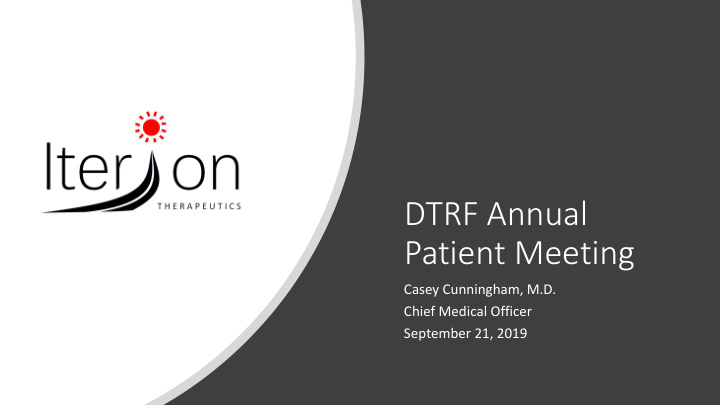



DTRF Annual Patient Meeting Casey Cunningham, M.D. Chief Medical Officer September 21, 2019
What is Tegavivint? • Tegavivint is a given as a once-weekly Desmoid Cell Line intravenous infusion that has been shown to decrease beta-catenin protein levels. • Desmoid tumors are known to solely be caused by elevated beta-catenin protein. • So, Tegavivint specifically targets the root cause of desmoid tumors Tegavivint 2
Phase 1/2a clinical study enrolling patients • Open-label, multi-center, non-randomized study to evaluate safety of Tegavivint in patients with a desmoid tumor that is unresectable and symptomatic or progressive. • Once weekly intravenous infusion. Three weeks on drug followed by a week off. • Enrolling at six centers in United States and one in Canada. • Currently enrolling 6 th cohort in Phase I dose escalation portion of study. • All patients participating in Phase I will have the choice to automatically escalate to the recommended phase 2 dose (RP2D) when we transition to the Phase 2a expansion phase of study, which will include 25 patients. • For more information please visit (https://clinicaltrials.gov/ct2/show/NCT03459469?term=tegavivint&rank=1) 3
Phase I clinical trial update • Twelve patients have been treated by drug with 10 months being the longest treatment time Tumor Growth 50 3-01, 1 mg/kg (cohort 2) • No significant drug related side effect reported 40 03-02, 2 mg/kg 04-01, 2 mg/kg (cohort 3) 30 %Change from baseline (WHO) 05-01, 2 mg/kg 20 • Patient receive MRI scan every three months 04-02, 3 mg/kg (cohort 4) 02-01, 3 mg/kg 10 (cohort 5) 05-02, 3 mg/kg 0 3 6 9 -10 • All treated patients have stable disease with -20 decreasing tumor size in those that have received at -30 least six cycles on drug -40 -50 Time in treatment (Months) • Due to low toxicity profile and preliminary efficacy, patients and physicians requested that we amend clinical protocol to allow for up to two years of treatment 4
Currently enrolling clinical centers Institution Investigator Study Coordinator Princess Margaret Cancer Centre (Toronto, ON) Albiruni Razak, MD Horace Wong, MSc, HonBSc horace.wong@uhn.ca Dana Farber Cancer Institute (Boston, MA) Suzanne George, MD Abigail Porcello aporcello@partners.org Massachusetts General Hospital (Boston, MA) Edwin Choy, MD Lia Tamburello lmtamburello@mgh.harvard.edu Seattle Cancer Care Alliance (Seattle WA) Lee Cranmer, MD Roxanne Moore romoore@seattlecca.org MD Anderson Cancer Center (Houston, TX) Vinod Ravi, MD Giberto Botello Shreyaskumar Patel, MD GBotello@mdanderson.org Memorial Sloan Kettering Cancer Center (New York, NY) Mrinal Gounder, MD Moriah Martindale martindm@mskcc.org The Ohio State University Comprehensive Cancer Center David Liebner, MD Cassondra Faiella (Columbus, OH) Cassondra.Faiella@osumc.edu 5
Recommend
More recommend